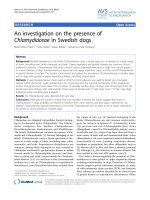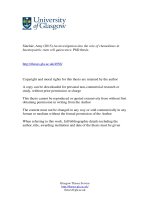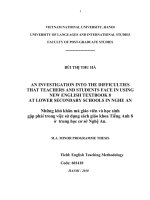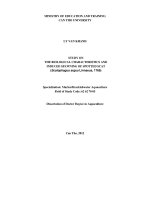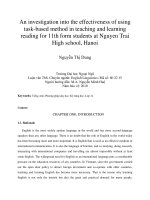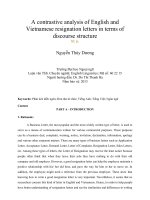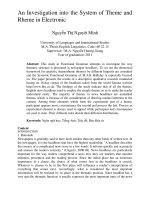an investigation on the satisfaction of the learnersí needs in the course american culture and society
Bạn đang xem bản rút gọn của tài liệu. Xem và tải ngay bản đầy đủ của tài liệu tại đây (572.46 KB, 36 trang )
An Investigation on the Satisfaction of the Learners’ Needs in the Course American Culture and Society
CAN THO UNIVERSITY
SCHOOL OF EDUCATION
ENGLISH DEPARTMENT
AN INVESTIGATION ON THE SATISFACTION
OF THE LEARNERS’ NEEDS IN THE COURSE
AMERICAN CULTURE AND SOCIETY
B.A. Thesis
Supervisor:
Researcher:
Nguyen Thi Phuong Hong, M.A.
Nguyen Thi Ngoc Huong
Student’s ID: 7032500
B.A. Class NN0354A1
Course: 29
Can Tho, June 2007
Supervisor: Nguyen Thi Phuong Hong
1
Researcher: Nguyen Thi Ngoc Huong
An Investigation on the Satisfaction of the Learners’ Needs in the Course American Culture and Society
TABLE OF CONTENTS
Page
TABLE OF CONTENTS ................................................................................................2
ACKNOWLEDGEMENT ..............................................................................................3
ABSTRACT....................................................................................................................4
CHAPTER ONE: INTRODUCTION ............................................................................5
1.1 A brief history of the course American Culture and Society at Can Tho
University.......................................................................................................................5
1.2 Problem statement .........................................................................................6
CHAPTER TWO: LITERATURE REVIEW...................................................................8
2.1 Needs of learners ...........................................................................................8
2.2 Course goals and objectives ........................................................................ 10
2.2.1 Course goals .................................................................................... 10
2.2.2 Course objectives ............................................................................. 10
2.2.3 Reasons for course objectives .......................................................... 11
2.2.4 Turning goals to objectives ................................................................ 11
CHAPTER THREE: METHODOLOGY ..................................................................... 16
3.1 Design ......................................................................................................... 16
3.2 Participants ................................................................................................. 16
3.3 Instrument ................................................................................................... 16
CHAPTER FOUR: DATA ANALYSIS AND DISCUSSION ....................................... 18
4.1 Data analysis and discussion ......................................................................... 18
CHAPTER FIVE: LIMITATION, CONCLUSION AND SUGGESTION..................... 29
5.1. Conclusion ................................................................................................... 29
5.2. Limitation .................................................................................................... 29
5.3. Suggestion .................................................................................................. 30
REFERENCES ............................................................................................................. 32
APPENDIX................................................................................................................... 33
Appendix 1 Course evaluation forms
......................................................................... 33
Appendix 2 Questionnaire ............................................................................................. 34
Appendix 3 Bloom’s taxonomy of learning ................................................................... 36
Supervisor: Nguyen Thi Phuong Hong
2
Researcher: Nguyen Thi Ngoc Huong
An Investigation on the Satisfaction of the Learners’ Needs in the Course American Culture and Society
ACKNOWLEDGEMENT
I would like to express my deep gratitude to my supervisor, M.A. Nguyen Thi
Phuong Hong, who spent time discussing with me some initial research topics that might be
of my interest and who gave me close guidance, corrections, and encouragement during the
time I worked on the topic I chose.
I wish to give my best thanks to M.A. Thai Cong Dan, M.A. Truong Vo Dung,
M.A. Dang Thi Kim Mai, M.A. Truong Thi Kim Lien, M.A. Tran Thi Sau and Mr. Daniel
White for their willingness to be interviewed and for their useful information.
I also wish to thank M.A. Le Cong Tuan, who kindly allowed me to distribute to
and collect questionnaires back from the students attending his instruction.
72 students of English, both Bachelor and Pedagogy Training, from course 29 and
30, filled out the course evaluation forms, answered the questionnaires and responded my
follow-up questions. I thank them all for their effective cooperation and kindness.
Nguyen Thi Ngoc Huong
Supervisor: Nguyen Thi Phuong Hong
3
Researcher: Nguyen Thi Ngoc Huong
An Investigation on the Satisfaction of the Learners’ Needs in the Course American Culture and Society
ABSTRACT
Being knowledgeable of learners’ needs in a given course is of necessity because it
helps instructors adapt their instruction, curriculum and teaching materials to be able to
achieve desirable results in both teaching and learning. This study investigates the
satisfaction of the learners’ needs in the course American Culture and Society, in an
attempt to find out what students wish to learn from the course so that the teaching of
instructors becomes more satisfactory and effective. The data were collected from the
course evaluation forms and questionnaires administered to 72 students who already
completed the course and from the interviews with four instructors who have taught the
course. Some follow-up interviews with the learners were also conducted for a closer
inquiry of the course content and structure. The course evaluation forms asked generally
about the course content and teaching methods and the questionnaire was almost about
course objectives, materials and teaching approaches. The finding is hoped to assist the
instructors in designing course objectives and assignments, selecting course materials and
applying teaching approaches appropriate with the learners’ needs. The result showed that
learners were not taught authentic materials such as oral history, document films, and
scholarly articles and normally did not have choices of what they would study in the
course. Although the course objective was stated either at the beginning of the course or
sometimes during the course, there is no any course evaluation given during the course for
learners to express what they wanted to study and perform. Learners expressed desire that
some classroom assignments and activities like visual aid using, group work or group work
discussion, presentation and role play should be still kept in or added to the course and the
instruction should be emphasized much more on U.S cultural aspects and less on
Vietnamese ones.
Supervisor: Nguyen Thi Phuong Hong
4
Researcher: Nguyen Thi Ngoc Huong
An Investigation on the Satisfaction of the Learners’ Needs in the Course American Culture and Society
CHAPTER ONE
INTRODUCTION
1.1. A brief history of the course American Culture and Society at Can Tho University
(CTU)
American Culture and Society has been taught at CTU for many years. It is
considered an important part in English teaching and learning because in language teaching
and learning language and culture have a close relation. Teachers’ guideline often writes
that language teaching consists of teaching the four skills “plus culture.” This dichotomy of
language and culture is an entrenched feature of language teaching around the world.
Culture is often seen as mere information conveyed by language, not as a feature of
language itself; cultural awareness becomes an educational objective in itself, separate
from language. Some objectives when the course American Culture and Society was first
taught at CTU were to help learners comprehend some particular cultural aspects of the
U.S. such as geography, living style and history and improve their English speaking skill.
Later, there was a change in the course objectives; that was “after the course, the students
would be able to compare similarities and contrast differences between Vietnam and the
U.S. in terms of family, government, table manners, marriage and religion, which was
interviewed from the course instructors. It seems that at this point American Culture and
Society functioned as a mean to help learners explore more about Vietnamese Culture and
Society.
Besides, course materials that instructors have used in the course are various.
British-American Civilization, Spotlight in the U.S.A., Meet the U.S., Aspects of Britain
and the U.S.A., Yesterday and Today in the U.S, Cultural Puzzle, and Culturally Speaking
have been required course books which have used singly or combined with one or two
Supervisor: Nguyen Thi Phuong Hong
5
Researcher: Nguyen Thi Ngoc Huong
An Investigation on the Satisfaction of the Learners’ Needs in the Course American Culture and Society
others. At the present, the English Department recommends using the three books Cultural
Puzzle, Culturally Speaking and Spotlight in the U.S. for the course. Over time, the
position of American Culture and Society in English teaching at CTU has been
strengthened. It not only helps widen students’ knowledge about the U.S. cultural aspects
such as living styles, geography, and government but also enables the students to better
study other subjects like Speaking, Reading, and American Literature. In fact, according to
the English Department Vice Dean Thai Cong Dan, the course will be a foundation for
American Studies, a new field of study planned to be offered at CTU in the near future as
an elective course. It is clear that American Culture and Society is an indispensable part in
English teaching and learning.
1.2. Problem statement
American Culture and Society is a useful subject in the English program. However,
in an informal survey done in November 2006 in which 72 learners already taking the
course responded to the course evaluation forms issued by CTU, more than fifty percent of
them felt that the knowledge they obtained from the course was too far from satisfactory.
They experienced that the course has given them excessive information of the U.S.
geography, which lessened their attention to the lecture and their interest in the course. In
addition, no research of learners’ needs of the course has been carried out at CTU. These
seem to be a lack at some points of the course. I would like to investigate if this negative
perception is supported by strong data. I also would like to investigate what the learners’
needs are. Therefore, two research questions were posed:
● To what extend the course American Culture and Society satisfies learners ’
needs in terms of course objectives, teaching materials and teaching approaches?
● What are the learners’ needs in the course American Culture and Society?
Supervisor: Nguyen Thi Phuong Hong
6
Researcher: Nguyen Thi Ngoc Huong
An Investigation on the Satisfaction of the Learners’ Needs in the Course American Culture and Society
The data will focus on the course objectives, teaching materials and teaching
methods. The result of the study is hoped to get instructors informed of learners’ needs;
and thus, assist them in designing course objectives, selecting materials and, and applying
teaching methods appropriate with the learners’ needs.
From the informal survey about learners’ general perception of the course, the
research questions, and aims, the researcher raises a hypothesis that although the course
objectives had been prepared before the course started and were stated either at the
beginning of the course or sometimes during the course, the teaching materials and
methods were somewhere not at learners’ interest and needs. This hypothesis can
direct the researcher in designing questionnaire and questions for the interviews and
choosing the appropriate data collection method as well as instruments for analyzing the
data.
Supervisor: Nguyen Thi Phuong Hong
7
Researcher: Nguyen Thi Ngoc Huong
An Investigation on the Satisfaction of the Learners’ Needs in the Course American Culture and Society
CHAPTER TWO
LITERATURE REVIEW
2.1. Learners’ needs
Becoming a good teacher, one who meets the needs of most learners, is not an easy
task. Good teachers consider the individual needs of their students, make the necessary
modifications and meet those needs (Russell, 2000). This is a high standard to achieve at
students with a different range of ability levels. These students challenge instructors to
meet their needs. In a given class, there are at least some students functioning at an
advanced level, some other ones functioning at low-basic level, and the other are
somewhere in the middle academically. Therefore, instructors have to consider how best to
convey the information in their lesson to reach all of their students.
In other words,
instructors should take into consideration of multi-level teaching, which exposes all
learners to the same lesson as their peers, but at various levels of difficulty. (Salend, 1998:
298). It means that instructors will teach all their students the same subject at the same
time, but give them assignments based on their ability.
Collicott’s four-step process for the design of multi-level instructional lessons is
cited in Salend:
Step 1: Identification of underlying concepts
Teachers identify and examine the goals, objectives and materials of the lesson and
determine potential content and skill level differences.
Step 2: Consideration of the method of teacher presentation
Supervisor: Nguyen Thi Phuong Hong
8
Researcher: Nguyen Thi Ngoc Huong
An Investigation on the Satisfaction of the Learners’ Needs in the Course American Culture and Society
Teachers consider the different learning styles and cognitive and participation
levels of students as well as the various presentation mode that can be used to present the
lesson.
Step 3: Consideration of the methods of student practice and performance.
Teachers consider the different ways students can practice and show mastery of
skills and concepts. Teachers also employ methods for teaching students to accept the
differing response modes for demonstrating skill mastery and understanding of concepts.
Step 4: Consideration of methods of evaluation
Teachers consider a variety of ways to assess students’ mastery.
Another important aspect of multi-level education involves creating an effective
learning environment. Some common characteristics of these environments according to a
study by Brain which is cited in Bauer and Shea (1999, 1777) include:
●
High expectations for students’ learning
●
Clear and focused instruction
● Using incentives and rewards to promote learning
● Enforced high standards for classroom behavior (Bauer and Shea, 1999: 177 )
Another component of an effective learning and teaching environment is teacher
enthusiasm. By creating a very positive atmosphere, teachers can greatly increase chance
for student success (Mercer &Mercer, 1998:39). Creating a positive atmosphere and
effective learning environment will be a very worthwhile and rewarding undertaking.
Meeting the needs of all learners is not easy for teachers. The first step in the
process is consciousness of the challenge and then makes adaptations when necessary to
Supervisor: Nguyen Thi Phuong Hong
9
Researcher: Nguyen Thi Ngoc Huong
An Investigation on the Satisfaction of the Learners’ Needs in the Course American Culture and Society
meet a diverse range of needs. If teachers can make adaptations and improvements
effectively, they will be reaching all learners in their class.
In four steps of designing multi-level instruction, course goals and objectives,
materials, and teaching approaches are the three most necessary factors. Of them, course
goals and objectives are the most important component for lesson plans. If they are written
well, an instructor will have an effective and meaningful structure for course content,
method of instruction, reading material and forms for assessment.
2.2. Course goals and objectives
2.2.1. Course goals
Course goals explain the reasoning behind what instructors will teach in a course.
They articulate what instructors wish to accomplish and help to map their direction. They
address the question: what do instructors want their students to take with them after the
course is completed? Once they have organized their goals, they can decide what content
and teaching method will best achieve them.
●
Goals state what a student should be able to do at the end of the course; they do
not describe the learning process.
●
Goals for one session are often related to goals for the entire course.
●
Goals should be clear and reachable, concentrate on naming the most important
broad concepts.
(Goals and objectives, 2004)
2.2.2. Course objectives
Course objectives are student performances of the concepts described in the course
goals. They are often referred to as “learning outcomes” because they define more
Supervisor: Nguyen Thi Phuong Hong
10
Researcher: Nguyen Thi Ngoc Huong
An Investigation on the Satisfaction of the Learners’ Needs in the Course American Culture and Society
specifically what skills and knowledge students will be able to demonstrate after the
course. They can be used to assess the effectiveness of the course.
●
Objectives should always focus on the students, not the instructor.
●
Objectives should address outcomes, not learning processes.
●
Each objective should focus only one idea.
●
Objectives should measure specific behaviors. Try to avoid using vague verbs
such as “understand” and “know”.
(Goals and objectives, 2004)
2.2.3. Reasons for course objectives
Course objectives are useful for students, instructors and instructional designers.
Some of the ways in which they are used to include:
●
To select and design instructional content, materials, or methods, it is necessary
to have a sound basic by which success can be measured. Clearly defined objectives allow
designers and instructors a method to find how successful their material has been.
●
The purpose of instruction is to improve performance. By clearing stating the
results we want the learners to accomplish, we can identify if they have gained the
appropriate skills and knowledge.
●
Because objectives should be stated before learners begin their instructional
materials, they provide students the means to organize their efforts toward accomplish the
desired behaviors.
(Reason for objectives, 1996)
2.2.4. Turning goals to objectives
Supervisor: Nguyen Thi Phuong Hong
11
Researcher: Nguyen Thi Ngoc Huong
An Investigation on the Satisfaction of the Learners’ Needs in the Course American Culture and Society
At the workshop organized by a Fulbright scholar
(1)
at the English Department,
CTU in April 2007, the audience was introduced to the following enlightening information
on course goals and objectives. (2)
The following examples will illustrate the process of turning un-assessable course
goals into assessable course objectives. To make this shift, we need to change our thinking
from “course-focused” to “student-focused”. In other words, we need to look at what
students actually get out of a course, and not what we think the course will give them.
It is important to note that we do not ask too much from any one course. Two or
three well-designed outcomes can result in more effective learning than four or five
ambiguous course goals. In order to achieve higher-level critical thinking and writing skill,
courses need to be designed so that these skills are built incrementally.
In the following examples, Rice has utilized Bloom’s Taxonomy (see appendix 3)
of learning and underlined and placed in boldface the key terms taken from the Bloom.
Example One from the course Cross-Culture Perspectives (3)
Old course goal: “To encourage students to look for similarities and differences
between their culture and other cultures.”
New course objective: “Students will be able to describe and explain significant
similarities and significant differences between American Culture and Vietnamese
Culture.” (This objective demonstrates the students’ knowledge and their ability to
analyze features of their own and another culture.)
1. Professor Mark Rice was a 2006 U.S. Fulbright scholar at Can Tho University
2. The two examples are copied from the workshop’s handouts;
3. This course is taught in TEOSL Master s program at CTU
Assignment: Students will complete multiple homework assignments that describe
and explain features of their own culture as well as the class readings. By asking them to
Supervisor: Nguyen Thi Phuong Hong
12
Researcher: Nguyen Thi Ngoc Huong
An Investigation on the Satisfaction of the Learners’ Needs in the Course American Culture and Society
explain significant similarities and differences, we will be able to determine the depth of
their understanding of culture.
Explanation: The old course goal is somewhat student-centered, but it does not ask
students to be held accountable for their understanding of cultural similarities and
differences. The new course objective expects concrete results from the students- they have
to both describe and explain, which asks them to move from the level of knowledge to the
level of analysis, a move that is not always easy for them to make.
Example Two from the course Cross-Cultural Perspectives
Old course goal: “To give insights into how to teach culture through language
more successfully.”
New course objective: “Students will be able to integrate the teaching of American
Culture with the teaching of the English language.” (This objective demonstrates the
students’ ability to synthesize classroom information with existing knowledge and skills.)
Assignment: Students will be asked develop five lesson plans that incorporate
elements of culture into language learning. They will help present one of their lesson plans
in front of the class.
Explanation: In the old course goal, the focus is on what the course intends to
teach the students, but it does not adequately reveal whether of not the students are able to
“teach culture through language more successfully.” The new course objective, however,
includes a key word that can lead to effective assessment.
By having students develop an assignment of their own, we can determine whether
they are able to do the kind of integration that they have been asked to do. If most students
cannot “integrate the teaching of culture with the teaching of language,” we need to ask
Supervisor: Nguyen Thi Phuong Hong
13
Researcher: Nguyen Thi Ngoc Huong
An Investigation on the Satisfaction of the Learners’ Needs in the Course American Culture and Society
ourselves why that is the case, and whether or not we need to modify our course design or
delivery in order to allow students to more effectively achieve the desired outcome.
In a language-teaching course, skills-based and knowledge-based objectives are
usually considered at the same time. It is knowledge-based because it requires that students
learn certain facts and concepts. Am example of a skills-based objective for this course
might be “learners’ English speaking skill is enhanced.” This is a skills-based objective
because it requires that students learn how to do something. To determine the level of
expertise for each measurable student outcome, first decide to which of these two
categories the corresponding course objectives belong to. Then, using the appropriate
Bloom’s Taxonomy, look over the descriptions of the various levels of expertise determine
which description most closely matches the measurable student outcome. Therefore,
Bloom’s Taxonomy is a convenient way to describe the degree to which we want students
to understand and use concepts, to demonstrate particular skills.
It is suggested that students had better reach cultural knowledge-based objectives
with the level of expertise that they will able to describe and explain significant similarities
and differences between American Culture and Vietnamese Culture in the course American
Culture and Society. At this level, critical thinking is required in learners’ response of these
similarities and differences so that the learners are able to analyze them. Another objective
that students need to reach is speaking skills-based. They learn how to use cultural aspects
of English speaking in real-life situations. For example, Americans consider a “verbal”
culture to show their feedback in communication. White they are talking, they often say
phrases and sounds like “oh, I see”, all right”, “oh, sure”, “uh,huh”, etc to show that they
are listening and that they understand. In the following dialogue between Bill and Tak, Tak
gives Bill feedback by using sounds and words to show Bill “I am listening”, “I
understand”, and “I don’t understand”:
Supervisor: Nguyen Thi Phuong Hong
14
Researcher: Nguyen Thi Ngoc Huong
An Investigation on the Satisfaction of the Learners’ Needs in the Course American Culture and Society
Bill: “The hospital ordered two typewriters last month”
Tak: “Uh hud” (he nods his head)
Bill: “Get hold of Pierre….uh…. call him, or go see him”
Tak: “oh, I see”
(Levine, Deena R., Baxter, J., McNulty, P., 1987:59)
If Americans do not receive a lot of verbal feedback, they may feel that the other
person is not listening, is bored or angry or that he or she disagrees (Levine, Deena R.,
Baxter, J., McNulty, P., 1987). Contrary to Americans, Vietnamese people usually respond
to another person nonverbally. Vietnamese listeners normally keep silence and seldom ask
questions when they do not understand. This character of Vietnamese may cause confusing
in communicating with Americans who often feel uncomfortable with silence. American
speakers may think that listeners are not interested and feel bored in talking to them. If
Vietnamese learners apply this “verbal culture” or speaking skill in their talking, they will
interact more effectively in English. Generally, the second objective should say that after
the course American Culture and Society, students will be able to apply the learning of
American Culture and Society in the learning of English language. I believe the two
objectives suggested should be considered when instructors design the course American
Culture and Society.
Supervisor: Nguyen Thi Phuong Hong
15
Researcher: Nguyen Thi Ngoc Huong
An Investigation on the Satisfaction of the Learners’ Needs in the Course American Culture and Society
CHAPTER THREE
METHODOLOGY
3.1. Design
Descriptive and quantitative approaches are used to investigate the satisfaction of
the learners’ needs in the course American Culture and Society. The CTU course
evaluation form (CEF) was first administered to English students who already took the
course to get their general ideas about the needs of learners in the course. Based on the
result of the CEF, interview questions were designed and answered by participants for
more reliable data to analyze learners’ satisfaction of the course.
3.2. Participants
The participants the researcher chose included four instructors of American
Culture and Society and 72 English students who already took the course American
Culture and Society. The researcher wanted to choose four instructors of the course
because they are able to provide the researcher information about the course content and
structure. The students were of Bachelor of English course 29 and of Education of English
course 30 at CTU. The first group of course 29 finished the course in fall 2005 and the later
group of course 30 in fall 2006. The researcher investigated the two different groups of
students studying the course American Culture and Society in different period with the
purpose of examining whether or not the satisfaction of their needs in the course is similar
in other that the researcher can get an overview of learners’ needs.
3.3. Instruments
CTU Course Evaluation Forms, questionnaires, and interviews were used to collect
the data.
Supervisor: Nguyen Thi Phuong Hong
16
Researcher: Nguyen Thi Ngoc Huong
An Investigation on the Satisfaction of the Learners’ Needs in the Course American Culture and Society
3.3.1. CTU Course Evaluation Forms: Questions asked generally about the course
content and teaching methods.
3.3.2. Questionnaires: questions asked for course materials, objectives, teaching
methods and learners’ needs.
3.3.3. Interviews: The student interview discussed again questions in the
questionnaires. The purpose of this session was to better examine what the students’
responses to the CEF and questionnaire actually meant. The instructor interviews were
conducted with questions about course objectives, contents and evaluations.
Supervisor: Nguyen Thi Phuong Hong
17
Researcher: Nguyen Thi Ngoc Huong
An Investigation on the Satisfaction of the Learners’ Needs in the Course American Culture and Society
CHAPTER FOUR
DATA ANALYSIS AND DISCUSSION
4.1. Data analysis and discussion
Questionnaires (see appendix 2) were administered to 72 students who took this
course. The second question in the questionnaire asked about what course texts were used.
Half of the informants who were English Bachelor students of course 29 said that they
used the two textbooks Cultural Puzzle and Spotlight in the U.S. and the other half, English
Educational students of course 30, used Culturally Speaking and Spotlight in the U.S. as
their required textbooks. Although the two textbooks Cultural Puzzle and Culturally
Speaking are different, they convey the same content: cross-cultural communication,
which, therefore, is the reason why the researcher chose learners who were taught different
course books. The course instructor also gave them some handouts for further readings of
U.S. history and maps. The learners studied responded to the third question in the
questionnaire that famous places and customs such as greeting, addressing, and expressing
emotion and customs were the two most liked readings. The learners were interested in
some famous places in the U.S. because the landscapes were terrific and suitable for
traveling like dreamlike beaches in California and Hawaii. The students had a chance to
present one of these well-known regions so they could memorize most information. It
seemed that what learners still memorized were also what they were most excited to.
Besides, the fourth question that asked which reading the learners liked least
received confusing answers. About a quarter informants either had no response or
answered this question too generally: “I don’t remember.” It might be explained that
learners were introduced mostly general information in textbooks about the U.S., they did
not have chances to discuss aspects of the information deeply, so they easily forgot most of
Supervisor: Nguyen Thi Phuong Hong
18
Researcher: Nguyen Thi Ngoc Huong
An Investigation on the Satisfaction of the Learners’ Needs in the Course American Culture and Society
the information right after being taught. For example, if they studied theoretically that
many kinds of family were currently existed in America: nuclear family, extended family,
two pay-check family, single-parent family, adoptive or foster family and blended one
(Elaine Kirm &Pamela Hartmann, 1996). After that there was no discussion for the
learners to distinguish the family types. It was surely accepted that they faced challenge in
differentiating the American families when being asked. If they had a chance to discuss in
group and tell each other what their family type was and explained why it was, they could
easily memorize and distinguish the family differences. Besides, the book Spotlight in the
U.S. was also discussed by 7 responders. This book was reported to be difficult for
students to follow since it included a lot of new vocabulary and less cultural information
which was mostly about geography. In addition, 6 other students shared an idea that the
U.S. government information was not exciting. It seemed that the students did not have a
chance to express their opinions of the material content at anytime during the course time.
Although they did not liked some aspects of the content as mentioned above, they were
still instructed these aspects without any comment. In fact, the instructors interviewed
admitted that the course lacked some kinds of course evaluation. Therefore, students
normally had no choice of what they would study in the course and no chance to show
their thought.
Another confusing point dealt with course objectives. Although most of the learners
surveyed agreed that the course objectives or outcomes were stated either at the beginning
of the course or sometimes during the course. Only 15 students could express the objective
of the course they took The others gave their feedback on various cultural aspects such as
American customs, ways of addressing and daily life, maps and pictures, habits of people
and traditional festivals, etc. It might be explained that although the course objective was
stated, learners were not directed to make any effort to accomplish the desired objective.
Supervisor: Nguyen Thi Phuong Hong
19
Researcher: Nguyen Thi Ngoc Huong
An Investigation on the Satisfaction of the Learners’ Needs in the Course American Culture and Society
They just tried to finish whatever they were assigned to do so that they did not have to take
the course again. Consequently, they forgot the main purpose of the course that after the
completion of the course they would be able to compare the similarities and contrast the
differences between Vietnam and the U.S in 5 cultural aspects: family, government, table
manner, marriage, and religion, and just remembered some aspects of the course which
seemed impressive and interesting. For the multiple-choice question asking them to choose
the objectives that best suits the ones they had, the answer seemed to be clear now. The
multiple-choice question says:
After successful completion of the course, students will
be able to (a) compare the similarities and contrast the differences between Vietnam and
the U.S. in 5 cultural areas: family, government, table manners, marriage, and religion, (b)
comprehend 5 U.S. cultural aspects of family, government, table manners, marriage, and
religion, (c) response a particular U.S. cultural aspect in a written form, and (d) present a
particular U.S. cultural aspect in front of class.
There was good news from students’ feedback that the current objective of the
course was supported by many learners: 59 agreements for the answer (a), 21 ones for each
(b) and (d) and just 7 choices for (c). From this result, it can be said that instructors did a
good job in the course. They defined specifically what skills and knowledge students
would be able to demonstrate after the course.
Turning to the course methodology, I started with learners’ oral participation in
class. I wondered how often students participated orally in class. 39 informants replied that
they frequently did and the other 33 seldom did. The reasons why they did not very often
participate orally in class were reported to be they did not have any thing to say, which was
shared by 34 responses. Other 12 students preferred to listen and express their thought in a
written form. The number of students who agreed that the instructors did not give them a
chance to express their ideas orally was 11. And the other 4 showed that they were usually
Supervisor: Nguyen Thi Phuong Hong
20
Researcher: Nguyen Thi Ngoc Huong
An Investigation on the Satisfaction of the Learners’ Needs in the Course American Culture and Society
shy and afraid that their friends would judge their ideas when they participated orally. The
last had no choice for their passiveness. That over fifty percent of students studied
frequently participated orally in class showed their activeness which was very necessary in
language teaching environment. Students themselves made the class vivid and created a
good interaction between them and the instructors and vice verse, the instructors kept an
important role in controlling the classroom interaction:
! The teacher alone has the power to nominate a topic.
! The teacher controls the turn taking, by nominating a student, or selecting by
gesture or eye contact.
! The teacher initiates most exchanges, which may involve:
-
Informing the class about something
-
Directing students to do or say something
-
Eliciting a response (asking a question that she or he normally knows the
answer to- these are often called display questions)
-
Checking that something has been done
! The teacher finally evaluates the response.
(Jane Willis, 1998)
Typically, classroom interaction is made up of three-part exchanges in which the
teacher initiates, a student responds, and the teacher gives some feedback. And if the
teacher gives no feedback, the learners take this as a negative sign and go on trying to
answer until some feedback occurs.
The following exchange is typical of language
classroom:
The instructor: Okay, who can tell me who George Bush is? Yes? Ba
Supervisor: Nguyen Thi Phuong Hong
21
Researcher: Nguyen Thi Ngoc Huong
An Investigation on the Satisfaction of the Learners’ Needs in the Course American Culture and Society
Ba: uh…The president of the U.S.
The instructor: Good. The president of the U.S., yes.
In contrast, the learners’ passiveness mostly came from the fact that “they did not
have anything to say” which was indicated by 34 responses. As mentioned above, the
teacher has the power to open and close the classroom interaction, so why learners failed in
orally participating in class with an empty mind? It might be because the instructors
initiated the interactions with questions that learners did not know how to answer or with
questions which were not for the purpose of checking the old lessons. Also, the reason for
learners’ passiveness might be that learners were not encouraged to show their cooperation
by the way the instructors directed them to do something or by the way the instructors gave
feedback for their responses. Therefore, the instructor’s better to take a look in some
typical topics that Willis suggested in order to make the classroom interaction more vivid.
-
Informing the class about something
-
Directing students to do or say something
-
Eliciting a response (asking a question that she or he normally knows the
answer to- these are often called display questions)
-
Checking that something has been done
-
Evaluating the response
The answer to the question about what classroom activities the students were most
interested in was quite encouraging. Of assignments such as written exam, oral exam,
presentation, role-play, homework projects, reading response essay (response to what
learners read) and watching response essay (response to the films or videos learners
watched), homework projects and presentation were best done by much more students than
the other assignments, 26 choices for homework projects and 19 choices for presentation.
Supervisor: Nguyen Thi Phuong Hong
22
Researcher: Nguyen Thi Ngoc Huong
An Investigation on the Satisfaction of the Learners’ Needs in the Course American Culture and Society
The two assignments were suitable to the two objectives I mentioned in the literature
review: knowledge-based objective and skill-based objective. It was knowledge-based
objective because the homework projects asked from the learners were to respond a
particular Vietnamese cultural aspect or similarities and differences between Vietnamese
regions in a written form. The presentation helped the skill-based objective because
learners could improve their English speaking through presenting their task and listening to
other performances. In addition, before performing their task, learners spent a lot of time at
home on practicing speaking to have a fluent presentation. Therefore, the two types of
objectives should be considered at the same time in the future. By this, learners are not
only provided knowledge of the field of study but also have chances to develop language
skills.
Besides understanding what learners wanted to study, knowing how to teach
content well was the second leg of a tripod of language teaching. Each teacher has his or
her own teaching method that may be useful to one group of students but not to another.
For example, humor is culturally specific and will not be perceived the same way by all.
What the teacher thinks is amusing may be insulting to the students. Similarly, classroom
assignments are various, some of which may be appropriate to the course and some may
not. According to learners’ responses, homework projects and presentation were more
appropriate to the course American Culture and Society than the others. It conveyed an
implication that the two assignments should be kept in the course.
For classroom activities, the researcher suggested nine activities for students to
choose: pair-work discussion, group-work discussion, whole class discussion, lecturing,
presentation, listening to music, tapes, role-play, translation, and watching films or video
clips. The result was that watching films, video clips, group-work discussion, presentation
and role-play were the four items that learners were more interested in. Half of the students
Supervisor: Nguyen Thi Phuong Hong
23
Researcher: Nguyen Thi Ngoc Huong
An Investigation on the Satisfaction of the Learners’ Needs in the Course American Culture and Society
chose watching films, video clips as an indispensable part in the course American Culture
and Society. The second winner was group work discussion with 16 choices. The two next
one shared the same number of 15 choices were presentation and role-play. Learners
interviewed told that film or video clip watching was not applied in this course. It was clear
that they are likely to have film or video watching in the course.
It is said that students’ individual learning whether alone or in groups should be
supported; however, group work is an important element in a multi-level classroom
(Ressell, 2000). Weaker students can benefit by hearing what better students say and better
students can also improve through having to paraphrase and explain. If some groups finish
the task before the others, what they have done will be checked and compared to those of
the others’. Alternatively, they could find more information from the other groups.
The term “role-play” includes a wide range of activities, some of which have
outcomes to achieve, some of which do not. Some role-plays are actually problem-solving
tasks. In a cultural situation based on a case study: correcting misunderstanding, where a
group of students one will say some things that are not correct, the others will correct the
misunderstanding without making that person embarrassed or lose face, they would
genuinely be trying to correct one another. When an American corrects someone, he or she
often begins with a “softening” sound, such as “uh” or “ohm” or a word or phrase such as
“well”, “I think”, or “actually” before disagreeing with some one (Levine, Deena R.,
Baxter, J., McNulty, P., 1987). Here there is an outcome for each side to achieve.
However, there are other role-plays where students are simply acting out predefined roles
with no purpose, except for practicing specified language forms. For example, in an
activity like in pairs, ask and answer questions using “do you like…?” “Yes, I do/ No, I
don’t”. The emphasis is closely focused on getting students to produce the right forms.
While acting, students are unlikely to mean what they say. If there is not outcome to
Supervisor: Nguyen Thi Phuong Hong
24
Researcher: Nguyen Thi Ngoc Huong
An Investigation on the Satisfaction of the Learners’ Needs in the Course American Culture and Society
achieve, they have no reason to set themselves goals of trying to correct someone.
Recording of classes where students are preparing and performing this of role-play shows
that there is often far more real communication at the planning stages, especially where
students with the same role are put together in groups to plan their strategies, than during
the role-play itself. It should be identified that the students were enthusiastic to do both
something with an achieved outcome and something easy with no result, which challenges
the instructors to fulfill their diverse needs.
As mentioned above, presentation is really helpful to learners. They study each
other through what they have performed in front of the class.
More supporting the classroom assignments and activities, an open question about
the teaching style was posed: “In what ways did and didn’t the teaching style enhance your
study?” There were some commonalties among the responses in the teaching style which
enhanced learners’ study. 11 students indicated the way the instructor presenting new
information enhanced their study. They said: “…she told extra experiences about the
U.S…”, “…the teacher gave specific examples relating to culture for her lecture...”, “…the
instructor had some interesting spots and culture that were new to me…”, “…she had
various way of giving information…,” etc.
Other 7 commonalties among the responses were group work or group work
discussion: “…she made us work in group that I was interested in sharing information”,
“…she created some activities and required the class practicing and discussing in group”,
“…the instructor let us discuss in group” and so on.
It is generally accepted that instruction focusing on conveying cultural knowledge
can both raise the level of learners’ attainment and speed up the ultimate rate of language
development. However, it is not necessary for students to learn all what the instructor
Supervisor: Nguyen Thi Phuong Hong
25
Researcher: Nguyen Thi Ngoc Huong

